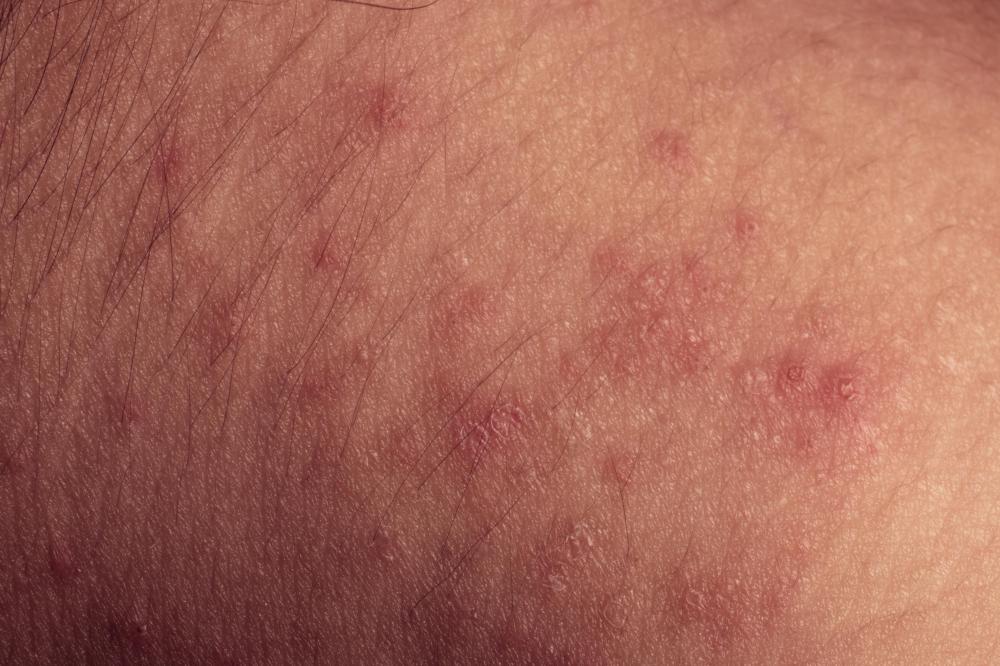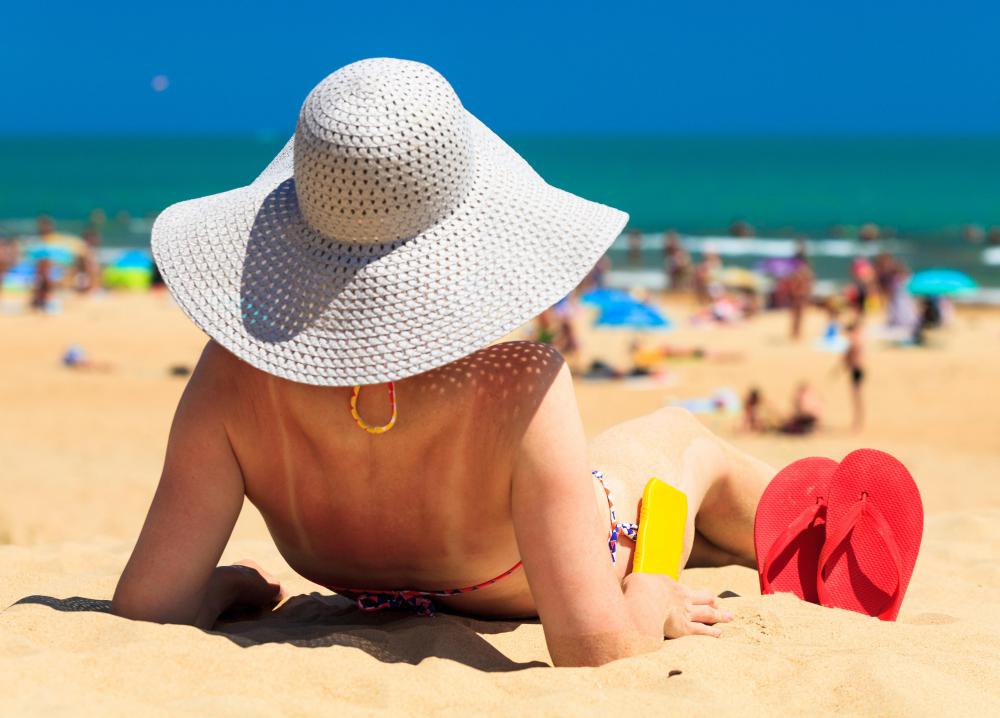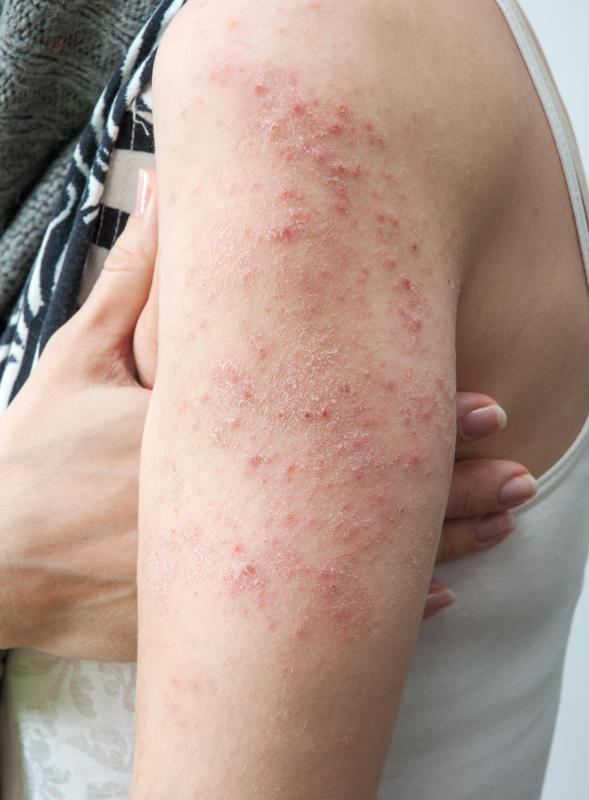At WiseGEEK, we're committed to delivering accurate, trustworthy information. Our expert-authored content is rigorously fact-checked and sourced from credible authorities. Discover how we uphold the highest standards in providing you with reliable knowledge.
How Can I Prevent Sun Rash?
Avoiding exposure to direct sunlight, especially during the early to mid-afternoon hours, is one of the most effective ways to avoid sun rash, although doing this is not always possible. Wearing lightweight clothing to cover the skin or using a sunscreen with a high sun protection factor (SPF) also can protect you. In addition to natural sunlight, tanning beds or sun lamps can cause sun rash and can be avoided to avoid the problem.
Once you have sun rash — an allergic reaction that appears as blotches, inflammation or small, itchy red blisters on skin that has been exposed to sunlight — you likely will develop it again. It sometimes is the body's reaction to sunlight. Skin products or exposure to chemicals and prescription medications also can cause sun rash.
Sun rash can appear within an hour of being in the sun. The time it takes for a rash to appear depends on your level of sensitivity to the sun. Areas of the body not normally exposed to sunlight are particularly vulnerable to developing sun rash.

You can protect your skin from sun exposure by wearing clothing that keeps most of your body covered. During very warm weather, lightweight clothing can be worn. Clothing that is extremely lightweight or see-through, however, might not be enough to prevent sun rash, because the sun's rays may be able to penetrate the lightweight fabric. A large hat and sunglasses can help keep the sun off your face.

A sunscreen with at least a 15 SPF can protect your skin while you are outside. An SPF of 15 means you should be able to stay in the sun up to 15 times as long as you would without sunscreen before having an adverse reaction. It is possible to reduce your SPF over time, if you are able to build up resistance to the sun.
A resistance to the sun can sometimes be developed through gradual exposure to sunlight over a period of time. This often is done under the guidance of a dermatologist or other medical professional. After extended periods with no sun exposure, it might be necessary to repeat the desensitization process.

If preventing sun rash doesn't work, then there are treatments to lessen the symptoms. Home treatment often is sufficient for milder cases of sun rash. Aloe vera gel, cold towel compresses or hydrocortisone creams can be used to reduce swelling and redness. Over-the-counter pain relievers also can reduce discomfort.
Unless you have a severe reaction to sunlight, total sun avoidance usually is not necessary. For extreme cases, it is best to consult a doctor. For milder cases, some trial and error with various preventive measures usually is all that is needed to determine what works best for you.
AS FEATURED ON:
AS FEATURED ON:


















Discussion Comments
I think that some people confuse a sweat rash with a rash from the sun. That makes sense because most people sweat when they are exposed to sunlight.
The difference between them is that a sweat rash occurs where the sweat glands are located, so on or around the armpits and the groin. A sun rash on the other hand can appear anywhere.
A great way to prevent both types of rashes is to wear long, but light 100% cotton clothing. Cotton stays cool and absorbs sweat. Frequent cool showers in hot weather, cold packs and aloe vera gel are other ways to prevent these types of rashes.
@donasmrs-- I'm sorry to hear that you're battling this.
My mom used to have a sunlight allergy. She would get a rash from the sun just as you, but her threshold for sunlight was a little higher. But she couldn't stay in the sun for longer than half an hour. Beach vacations were absolutely out of the question. She has very fair skin. I think those with fair skin often suffer from this allergy.
It might sound odd but she actually overcame this allergy by exposing herself to sunlight. She knew how long she could stay in the sun without getting a rash. So she started doing that every day. After several weeks of getting half hour of sunlight daily, her threshold started to increase. After several months, she could stay under the sun for several hours without getting a rash.
Since you are more sensitive, you can get the same type of therapy under doctor control. I think it's called UV therapy but I'm not sure. They will basically expose you to safe amounts of UV light on a regular basis to increase your tolerance. I think this is the only way to treat this condition. Talk to your doctor about this.
I think I'm allergic to sunlight. I develop a sun allergy rash every time I'm under the sun, despite using sunscreen as well as a large hat and sunglasses to protect myself. I'm so scared to go outside in the summer. Once the rash develops, it takes a few days for it to go away completely. The rash is itchy and sensitive.
Isn't there a solution to this? Do I have to live this way?
Post your comments